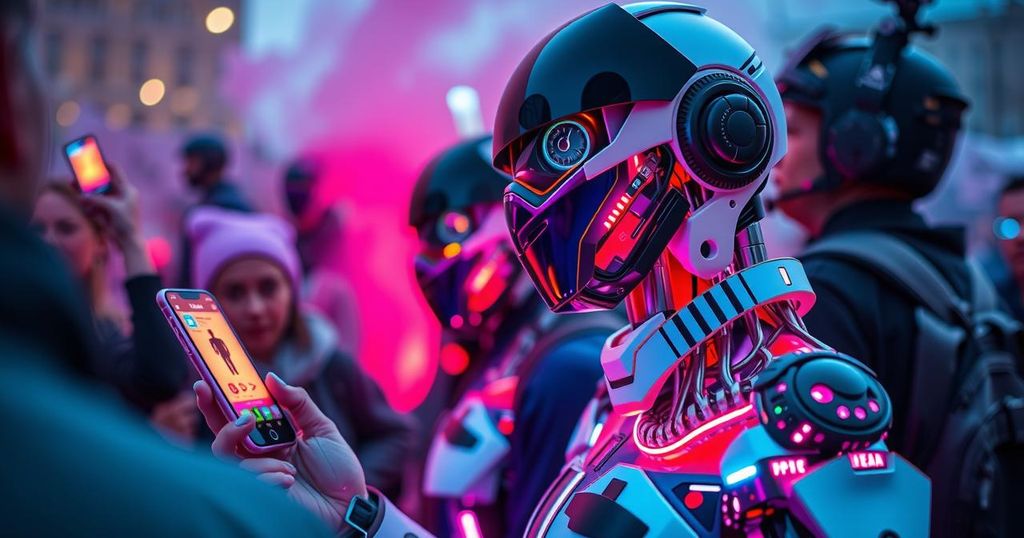The Intricate Dynamics of AI, Social Media, and Mass Protests: A Double-Edged Sword
Mass protests in today’s digital age are heavily influenced by AI and social media, which, while empowering movements, also contribute to misinformation and conflict. Recent events in Pakistan and Kenya illustrate how these technologies can manipulate narratives, ignite violence, and amplify political tensions. This juxtaposition calls for regulatory measures and a commitment to digital literacy to mitigate harmful impacts and ensure responsible use of technology in activism.
In our hyper-connected world, the volatile dance of mass protests is increasingly choreographed by the might of Artificial Intelligence (AI) and the pervasive reach of social media. These digital tools empower grassroots movements, facilitating coordination and unity among protesters. Yet, amidst this wondrous capability lies an insidious shadow—the generation and dissemination of misinformation, potential for heightened violence, and distortion of narratives that thrust society into chaos. Illustrating this dichotomy, we delve into the tumultuous protests in Pakistan and Kenya, exploring the intertwined fates of technology and activism.
In Pakistan, the recent upheaval following the arrest of former Prime Minister Imran Khan exposes the perilous intersection of AI and social media. The Pakistan Tehreek-e-Insaf (PTI) party rallied citizens, transforming peaceful demonstrations into a battleground amid rampant clashes with law enforcement. During this turmoil, AI-generated imagery penetrated the digital landscape, falsely depicting scenes of devastation and bloodshed. An image purporting to show bloodied streets of Islamabad, later revealed as AI-created, struck fear and incited further unrest. Fact-checkers uncovered its fallacy, identifying glaring inconsistencies like unusual shadows and distorted architecture. Such visuals escalated emotions, crafting a narrative that twisted reality into a frenzy of mistrust and aggression.
In the vibrant corridors of Kenya, the protests ignited by the controversial Finance Bill 2024 showcased the dual-edged nature of technological empowerment. Young activists harnessed social media platforms like TikTok and X to amplify their voices, crafting chatbots to expose government corruption and rally supporters. This spirited mobilization came at a price, however, as AI bots also dispersed targeted misinformation, fueling political discord and threatening the fragile fabric of societal unity. The Kenyan government echoed concerns over AI’s misinformation potential, reflecting a global fear articulated in the World Economic Forum’s Global Risks Report 2024. Here, technology serves as both a spear of empowerment and a sword of division, a complexity profound in its implications.
Globally, the scandalous influence of AI and social media transcends borders, as observed during the notorious 2023 UK riots. Misinformation spread like wildfire through social media, escalating aggression and chaos. One viral post falsely attributed a video of violence in Southend to the riots, inciting public panic and fostering a dangerous atmosphere of distrust. Such dynamics relate to a broader narrative—social media can twist reality, presenting a landscape where sensationalism outweighs truth. This phenomenon leaves a haunting imprint on the psyche, notably among the youth, who become susceptible to inflammatory content, their perceptions morphing in the flicker of a screen.
The underlying algorithms of digital platforms further exacerbate these issues by prioritizing emotionally charged content, often amplifying hate and divisive narratives. In places like Kenya, where ethnic identities are deeply rooted, misinformation can ignite age-old tensions, rewriting social bonds into hostile rivalries. As seen in the UK, algorithmic biases steer users toward provocative content, blurring the lines between fact and fiction, leaving societies teetering on the brink of violence.
To navigate this perilous digital landscape, a path forward is essential—one that necessitates regaining control over the narrative. The collaboration of governments and tech companies can birth frameworks promoting accountability, transparency, and effective content moderation. Prioritizing accuracy over sensationalism could pave the way toward a digital environment that fosters social cohesion rather than division. We must build a collective consciousness, championing digital literacy and critical thinking to resist the allure of misinformation.
AI and social media together hold the potential to amplify progress and unity, yet their darker facets can wreak havoc upon societal harmony. A concerted effort towards responsible use of technology, enhancing information verification mechanisms, and nurturing engaged communities can ensure that the digital age becomes not a cauldron of chaos, but a powerful tool for truth and justice.
The article dissects the significant impact of AI and social media on mass protests, highlighting both their empowering qualities and the risks they pose in terms of misinformation and violence. It examines specific instances in Pakistan, where AI-generated images fueled unrest during protests, and Kenya, where social media facilitated mobilization yet also spread dangerous misinformation. The article connects these themes to a broader global context, illustrating how social media shapes political movements and the potential repercussions of unchecked disinformation, ultimately addressing the urgent need for regulatory measures and accountability.
In conclusion, the interplay between AI, social media, and mass protests illustrates a pressing reality of our times—these digital tools can foster powerful grassroots movements while simultaneously threatening to distort truth and escalate conflict. The events in Pakistan and Kenya serve as salient reminders of technology’s double-edged sword. Moving forward, a focused effort on accountability, regulatory measures, and education about digital literacy is crucial to harness the positive potential of these platforms, ensuring they facilitate, rather than hinder, genuine progress and understanding in the public sphere.
Original Source: moderndiplomacy.eu




Post Comment